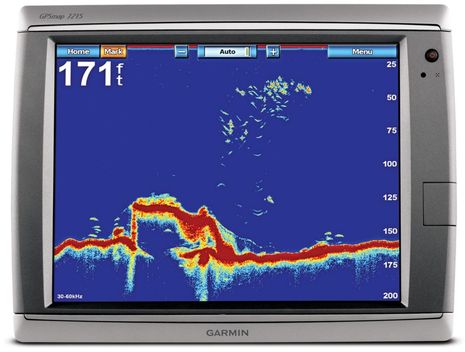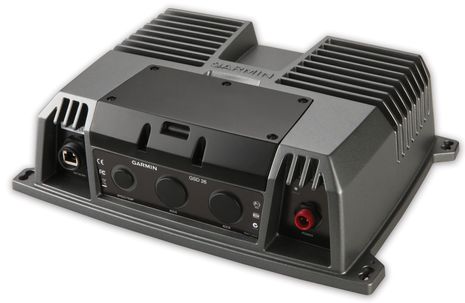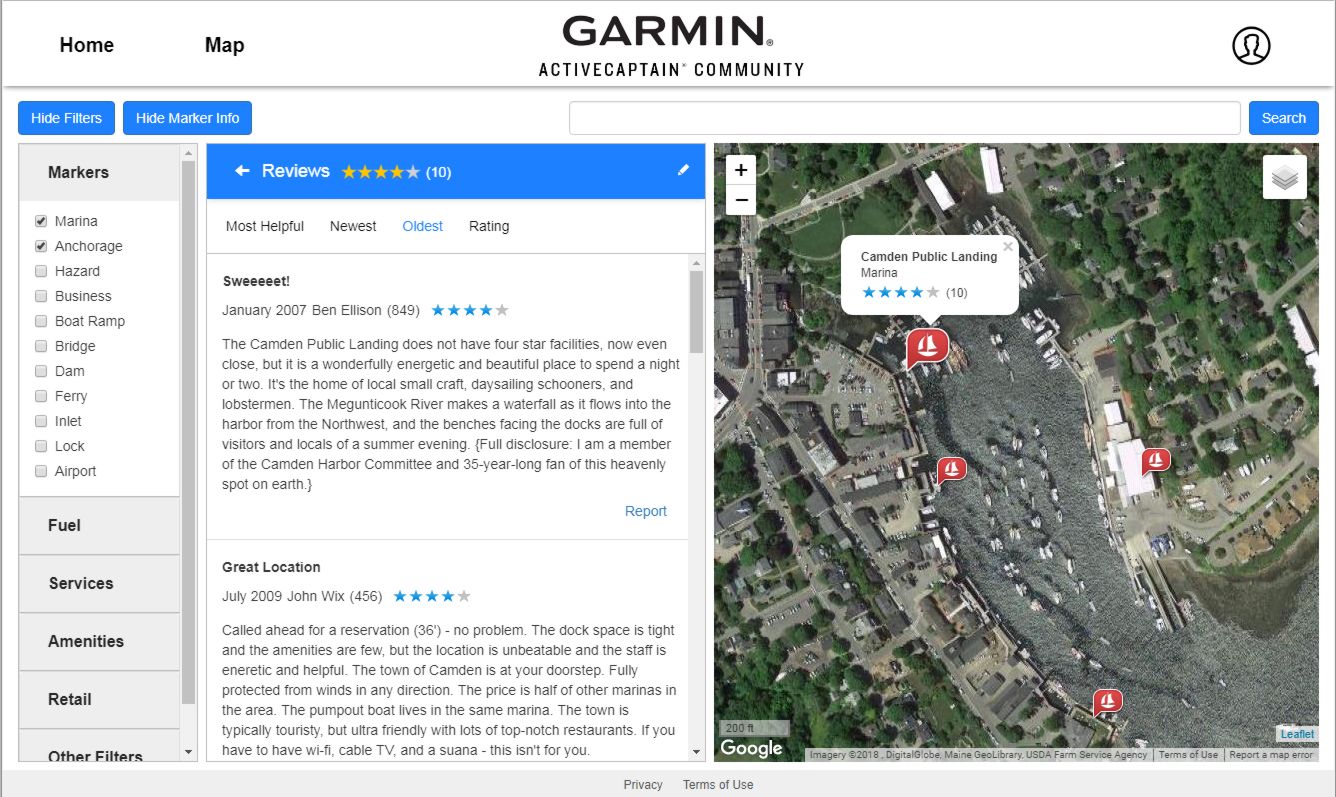Garmin GSD 26, serious sonar w/ CHIRP
So now a CHIRP war is breaking out. This morning Garmin announced two new black box fishfinders: The GSD 24 appears to be a $700 redesign of its previous top-of-the-line digital box while the $2,000 GSD 26 is an obvious play for the truly serious fishing crowd. The GSD 26 features “Spread Spectrum” technology, which seems to be another name for the CHIRP support that Simrad announced as part of its new BSM-2 box in September. In fact, both Garmin and Simrad will be running demos of their advanced fishfinding over the next couple of days off Miami, and I’ll be taking a ride with each…
Getting the most performance out of the new fishfinding boxes from Garmin and Simrad requires the use of one or more of the Broadband transducers that Airmar has been developing over the last several years. Yesterday, Airmar issued its own press release catching up with the various models they offer and the various names manufacturers have chosen for their own methods of processing and displaying frequency modulated sonar pings. At any rate, the performance claims are significant, as you can read in those releases. You might also learn something from Bill Bishop’s CHIRP musings and there’s discussion about Garmin’s new boxes happening on the Hull Truth. I certainly expect to learn something about Broadband-based fishfinding over the next two days, though it may take a while to report (lots more going on!). And what about Raymarine and Furuno? They both offer high-end black box fishfinders already, and with some support for Airmar’s Broadband transducers, like the ability to select a specific though non-conventional ping frequency to target specific fish species. It seems likely that they too will join the full-on CHIRP battle eventually.















The GDS 24 moves Garmin into the upper end of the recreational FF market. The sonar architecture used in this unit is totally new. The GDS 26 positions Garmin to move into the high end marine market. I was glad to see they took them time developing these two new FF. You’re going to see some dazzling FF technologies at the Miami Boat Show.
If you cant beat them, create something new. aka broadband.
Why would you want to have a broadband transducer that has a lower gain over a wide range of frequencies compared to a fixed frequency transducer that is much higher in gain?
The proof will be in the pictures though, I am not amazed with pictures of the bottom at 10000ft with a barely discernible bottom with fish ‘blobs’ I believe that these will still have a way to go before they catch up with serious fishfinder brands.
I think you may be confused, Chas, and that wouldn’t be surprising given that Simrad/Lowrance calls its low power digital FF technology Broadband and Airmar also calls its frequency agile transducers — some of which can be run up to 3kw — Broadband. Plus the two quite different Broadbands have come together in the Simrad BSM2 fishfinder.
At any rate, I was out today with a BSM-2 Broadband Sonar putting only 250 watts through an Airmar transducer rated for 2kw and the results were quite impressive in all depths from 4 feet to 1,100, using the CHIRP over two different frequency ranges. Tomorrow I’ll get to see what Garmin does with Spread Spectrum/CHIRP and more wattage.
raymarine.com/plottersync
have you seen this yet?
Hard to believe that Furuno will be left behind for long given that they have totally dominated the market at the upper end for so many years. Their most recent offering is pretty lame, just an ungrade to the DFF1 that allows some sort of bottom material identification (which sounds exactly like what someone with experience sees on the screen anyway without the cute graphics). Airmar has been marketing some of their high end transducers as “broadband” for a couple of years now. I have a pair of the SS270W tilted element which are called that and were not exactly cheap. But from the Airmar press release, it seems that these are not optimized for the new CHIRP sounders.
Ben, perhaps if you have the techs from Garmin or Airmar cornered, you can ask about the backwards compatibility.
Garmin CHIRP also Impressive. Too rough today to get off shelf to real deep water, but target discrimination around a fishy wreck in 80′ was “wow,” like the Simrad, and Garmin’s going for some interesting features Simrad lacks. The big picture most all my demo mates agreed on is that CHIRP seems to have true fishfinding value. The battle is on.
Quitsa, I also noticed that some broadband transducers apparently can’t CHIRP, which surprised me a bit. I meet with Airmar on Friday and will ask about yours.
Ben- – The chirp concept applied here to fish finders is akin to linear Frequency Modulation Pulse compression. Its been around for a long time but the problem has always been getting true linearity in the frequency chirp and then maintaining that linearity through the power amplifier (transmitter etc) the antenna (or transducer) and again on receive back through the transducer and receiver processing.
In the case of acoustic sensors water temperature and density / salinity may affect propagation speeds / amplitude as a functiion of frequency.
It does not surprise me that some transducers “cannot chirp” due to non-linearity in frequency response. Note that the acoustic frequencies you are talking about represent octaves of frequency range – where as for radar chirping involves a small percentage bandwidth of the carrier frequency – acoustic chirp seems to be covering octaves of frequency. Variation in transducer sensitivity as a function of frequency will degrade performance in a process called AM to PM conversion. Wide bandwidth may even cause the transducer to “squint” or scan its beam direction as a function of frequency – end fed antenna arrays also will scan or squint as a function of frequency.
This technology may be based on some very special transducers being tuned / tweaked for broadband operation – or means to precalibrate the transducer response so that it can be removed from the system during signal processing is needed.
Cannot work to great depths because of the distortion that will occur as a function of frequency due to water propagation as function of frequency. The waveform itself is badly deformed during propagation in water – that causes decorrelation in the signal processor and loss of sensitivity. I would expect them to consider a variable modulation scheme as a function of depth to provide overall coverage – for example conventional narrowband operation (1 or two single frequencies) for depths that defy the use of the waveform. I am very interested to see how this shakes out.
It will be very interesting to hear what Airmar says. I inadvertently misidentified mine, which are the SS264W tilted elemented pair but the question of backwards compatability is I am sure of general interest Apart from the expense, it would take a jackhammer to get those two 4″ diameter transducers out of my bilge to replace them. The mounting instructions call for vast application of 3M 4200 everywhere.
Looks like CHIRP ‘ducers are mostly new and none in the flush mount, thru hull design.
http://www.airmartechnology.com/uploads/brochures/broadband_pc_rA_lr.pdf
I’m wondering about my airmar b260,which they call a broadband transducer but it seems the chirp technology requires 2 separate transducers?
Only one transducer is needed for CHIRP, but it does have to be one of the new types of Broadband trasducers described in that Airmar press release. Both of the big center console fishing machines the trials were on had R209LH thru hulls mounted into custom pockets. They cost around what the black boxes do, north of 2,000. The older Broadband are frequency selectable within their ranges, a feature the Garmin has and the Simrad may get.
The Airmar B75 is a CHIRP flush mount with tilted element.
it will be used in pairs…low and high freq. or low and med.
Hi,
I have the Garmin GPSMAP7012 and the Airmar R99 2Kw thruhull transducer. Will the GSD 26 work with such a combination please???
Hi Karim, If you look on Garmin’s GSD 26 page you’ll see that your 7012 is definitely compatible. And if you download the Installation Guide you’ll see that the R99 is among the many transducers that the GSD 26 can drive. However, the GSD 26’s “Spread Spectrum” (aka CHIRP) features will not be available unless you upgrade to a CHIRP transducer: http://goo.gl/D8RyQ
I’ve heard that CHIRP fishfinders like the GSD 26 — which is now shipping, incidentally — will get the most out of any transducer, particularly a high quality one like the R99. But you need a CHIRP transducer to get full benefit.
Note that when I got to see CHIRP in action off Miami last February — http://goo.gl/sSpDt — both Garmin and Simrad were using Airmar R209LH transducers that weigh 46 pounds and cost about $3,000!
Dear Ben,
thank you for your reply which has been very helpful, however please note that i am now thinking of getting the R509LH Airmar.Do you think this combination of GPSMAP7012,Airmar R509LH, and GSD 26 is the best choice specially if i mostly do sport fishing at depths not exceeding 250 meters?
Thank you.
“Best” is always a tough call, Karim, but I think you’ll be very pleased with that set of gear. Screen shots from the GSD 26 taken by real users are starting to show up and they look great: http://goo.gl/g9sdF
At last I installed the R509LH with my GSD 26. I am going fishing this Friday and will feed you back with initial results. I tried it while setting up all the preferences and the results I saw, which I hope will be the same on deep water, Wr crazy (positively).
Tell me how to post some screenshots to share with you.
Regards,
Karim
At last I installed the R509LH with my GSD 26. I am going fishing this Friday and will feed you back with initial results. I tried it while setting up all the preferences and the results I saw, which I hope will be the same on deep water, Wr crazy (positively).
Tell me how to post some screenshots to share with you.
Regards,
Karim
Karim,
I have the same setup being delivered next week. what happened on your trip? is the r509lh a good transducer?
i got mine installed the day i posted the above message but since then we have been having storm after storm in Lebanon. I should be going out in the next couple of days and shall post some pics. All i need to know is how to be able to post pictures here pls if someone can tell me? As for the R509LH it should be a good transducer as it is a 3Kw transducer and thruhull, let’s wait and see…..
Karim, the best way to share your images is to use an online photo sharing site like Flickr or Picasa and then link to the folder in a comment here. It’s easier and better to take screen shots instead of trying to photograph the screen.
Hi,
Can you please clarify – were the demo boats fitted with shoot through hull or wet face transducers?
Thanks.
Wet face, but in a pocket so that the bottom of the transducer is fair with the hull. That technique means better transducer performance at speed and also that the boat isn’t slowed down or harder to put on a trailer.
hello i was wondering how many depth does this go
It all depends on the transducer being used.
With a 25 element unit .. the GSD26 will read easily down past 4000′
I have a screen shot of the GSD 26 holding bottom well at 17,600 ft plus with the Airmar 3K/2k (LH) transducer CHIRP transducer. It was taken by a Garmin engineer on a run from the Carolinas to Bermuda. It held bottom the entire way. Power does matter!
Here are several screenshots of the impressive test trip Bill references:
https://panbo.com/archives/2012/07/chirping_bottom_all_the_way_to_bermuda_maybe_fish_too.html
But then again check out the photograph of Simrad BSM-2 low-power CHIRP holding 1,100 foot bottom at 45 mph:
https://panbo.com/archives/2011/04/chirp_fishfinding_garmin_simrad_in_miami.html
I’m not sure Power matters much!